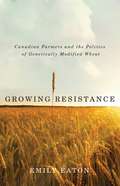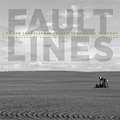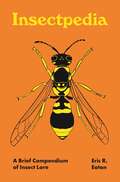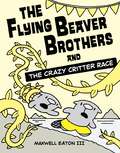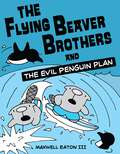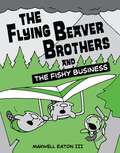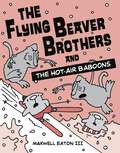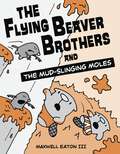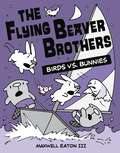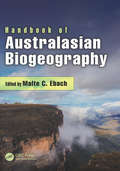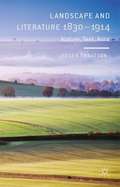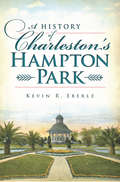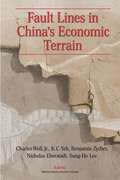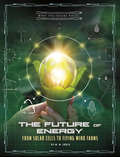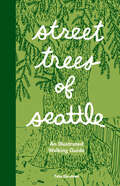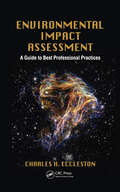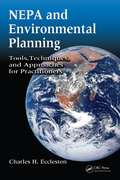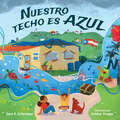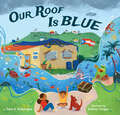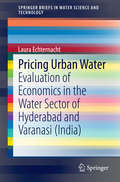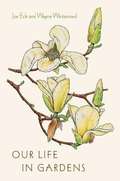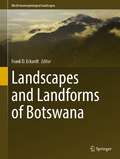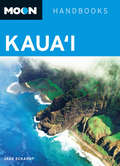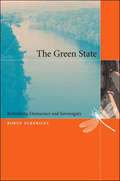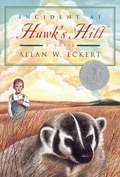- Table View
- List View
Growing Resistance: Canadian Farmers and the Politics of Genetically Modified Wheat
by Emily EatonIn 2004 Candian farmers led an international coalition to a major victory for the anit-GM movement by defeating the introduction of Monsanto's genetically modified wheat. Canadian farmers' strong opposition to GM wheat marked a stark contrast to previous producer acceptance of other genetically modified crops. By 2005, for example, GM canola accounted for 78 percent of all canola grown nationally. So why did farmers stand up for wheat? In Growing Resistance, Emily Eaton reveals the motivating factors behind farmer opposition to GM wheat. She illustrates wheat's cultural, historical, and political significance on the Canadian prairies as well as its role in crop rotation, seed saving practices, and the economic livelihoods of prairie farmers. Through interviews with producers, industry organizations, and biochemical companies, Eaton demonstrates how the inclusion of producer interests was integral to the coalition's success in voicing concerns about environmental implications, international market opposition to GMOs, and the lack of transparency and democracy in Canadian biotech policy and regulation. Growing Resistance is a fascinating study of successful coalition building, of the need to balance local and global concerns in activist movements, and of the powerful forces vying for control of food production.
Fault Lines: Life and Landscape in Saskatchewan's Oil Economy
by Emily Eaton Valerie ZinkOil is not new to Saskatchewan. Many of the wells found on farmland across the province date back to the 1950s when the industry began to spread. But there is little doubt that the recent boom (2006–2014) and subsequent downturn in unconventional oil production has reshaped rural lives and landscapes. While many small towns were suffering from depopulation and decline, others reoriented themselves around a booming oil industry. In place of the abandoned houses and shuttered shops found in many small towns in Saskatchewan, housing developments sprang up with new trucks and boats parked in driveways. Yet people in oil-producing areas also lived amid flare stacks that made them ill, had trouble finding housing due to vacancy rates that were among the lowest in the country, suffered through family breakdown because of long working hours and time spent away from home, and endured spills and leaks that contaminated their land. In the summer of 2014, at the height of the boom, geographer Emily Eaton and photographer Valerie Zink travelled to oil towns across the province, from the sea-can motel built from shipping containers on the outskirts of Estevan to seismic testing sites on Thunderchild First Nation’s Sundance grounds.
Insectpedia: A Brief Compendium of Insect Lore (Pedia Books #8)
by Eric R. EatonA fun and fact-filled A–Z treasury for the insect lover in all of usInsectpedia introduces you to the wonders of the insect world while inviting you to make discoveries of your own. Featuring dozens of entries on topics ranging from murder hornets and the “insect apocalypse” to pioneering entomologists such as Margaret James Strickland Collins and Douglas Tallamy, this beautifully illustrated, pocket-friendly encyclopedia dispels many common myths about insects while offering new perspectives on the vital relationships we share with these incredible creatures.This entertaining collection celebrates the long and storied history of entomology, highlights our dependence on insects for food and ecosystem services, and explains the meaning behind various entomological terms. With Eric Eaton as your guide, you will circle the globe in search of African Toktokkies and Australian beer bottle beetles, and witness the peculiar spectacle of cricket fighting in Asia. Profiles of influential figures in entomology provide insights into the curious minds that animate this extraordinarily broad field of scientific inquiry, while the book’s portable size makes it the perfect travel companion no matter where your own entomological adventures may lead you.With captivating illustrations by Amy Jean Porter, Insectpedia is an engaging blend of insect facts and folklore that will inspire anyone who delights in the marvels of nature.Features a real cloth cover with an elaborate foil-stamped design
The Flying Beaver Brothers and the Crazy Critter Race (The Flying Beaver Brothers #6)
by Maxwell EatonThe race is on for Ace and Bub in their sixth adventure in this popular young graphic novel series, which Kirkus called &“funny from the first panel!&” Ace and Bub are tangled up in an island-hopping competition, and there&’s more than just the grand prize—a houseboat!—at stake. The salesman and sponsor is Crazy Critter (and he really is craaazy), and it soon becomes clear that he has more than publicity for his houseboat dealership to gain from the race. Before long, the brothers are wrapped up in the plot: a fast-growing vine is entangling all the nearby islands! Which of their fellow competitors can help them put a stop to this outbreak—and which ones are behind it?
The Flying Beaver Brothers and the Evil Penguin Plan (The Flying Beaver Brothers #1)
by Maxwell EatonMeet Ace and Bub, the flying beaver brothers! Ace loves extreme sports and is always looking for a new adventure. Bub loves napping and, well, napping. But when penguins threaten to freeze Beaver Island for "resort and polar-style living," the brothers put their talents to work saving their tropical island paradise. Can they save Beaver Island from environmental destruction? And can they do it in time to still win the annual Beaver Island Surfing Competition?
The Flying Beaver Brothers and the Fishy Business (The Flying Beaver Brothers #2)
by Maxwell EatonThe Flying Beaver Brothers are back, and this time they're hot on the trail of another eco-villain: Fish Stix Environmental Manufacturing. When Fish Stix sets up shop, most of the islanders are thrilled. After all, Fish Stix are the most popular, best-selling sticks around AND they're good for the environment! But this eco-friendly facade is just a cover for a nefarious plot involving dirty money, fish who walk on dry land, and a great big smoking volcano. It's up to the dauntless beaver brothers to set things right—and they better do it fast or the island's forests are history! Now if only Bub can stop napping and they can all make enough pancakes to save the day. . . .This second installment to Max Eaton's new graphic series ups the ante in terms of both action and humor. The Flying Beaver Brothers are poised to take off as beloved comicbook heros.
The Flying Beaver Brothers and the Hot Air Baboons (The Flying Beaver Brothers #5)
by Maxwell EatonIn the fifth adventure of this popular young graphic-novel series perfect for fans of Captain Underpants and the Lunch Lady series, our bucktoothed heroes are up against a band of baboon bandits. It&’s winter break, and Ace and Bub are hitting the slopes! But their ski session is interrupted by a sudden influx of . . . swimming pools? A band of enterprising baboons has graced Beaver Island with the Easy Breeze, a giant hair dryer designed to melt all the snow off the mountains and channel it into swimming pools. The residents of Beaver Island are over the moon about their new relaxation stations, but Ace and Bub don&’t trust these monkeys any farther than they can ski down a hill with no snow. Can they uncover the baboons&’ real plan before their neighbors become too attached to the summery island makeover? With environmental themes, laugh-out-loud humor, and fast-paced adventures, the Flying Beaver Brothers are sure to fly off bookshelves!
The Flying Beaver Brothers and the Mud-Slinging Moles (The Flying Beaver Brothers #3)
by Maxwell EatonThe Flying Beaver Brothers are back! All is not well on Beaver Island. Ace and Bub have noticed a number of things (trees, houses, evil penguins) sinking into the ground. They soon discover that Captain Jo Jo and his scurvy crew of mud-making moles have hatched a nearsighted plot to steal dirt from Beaver Island to make their own island home even bigger! Can Ace and Bub stop their brotherly bickering and save Beaver Island before it disappears forever?
The Flying Beaver Brothers: Birds vs. Bunnies (The Flying Beaver Brothers #4)
by Maxwell EatonIn their fourth adventure, the Flying Beaver Brothers set off in their sailboat to enjoy some well-deserved rest and relaxation at nearby the island. But the birds and bunnies who live on Little Beaver Island have other ideas. Before long, Ace and Bub find themselves embroiled in an all-out war between the feathers and the fuzz. Can the Flying Beaver Brothers bring peace to Little Beaver Island?
Handbook of Australasian Biogeography (CRC Biogeography Series)
by Malte C. EbachThe Handbook of Australasian Biogeography is the most comprehensive overview of the biogeography of Australasian plants, fungi and animal taxa in a single volume. This volume is unique in its coverage of marine, freshwater, terrestrial, and subterranean taxa. It is an essential publication for anyone studying or researching Australasian biogeography. The book contains biogeographic reviews of all major plant, animal and fungal groups in Australasia by experts in the field, including a strong emphasis on invertebrates, algae, fungi and subterranean taxa. It discusses how Australasia is different from the rest of the world and what other areas share its history and biota.
Landscape and Literature 1830–1914
by Roger EbbatsonThis study examines the vital centrality of 'readings' of nature in a variety of literary forms in the period 1830-1914. It is exploratory and original in approach, stressing the philosophical and cultural implications in a range of texts from Tennyson, Hardy, Jefferies and Thomas.
A History of Charleston's Hampton Park
by Kevin R. EberleMost visitors to Charleston never venture far enough north to discover what residents claim as the most appealing public open space on the peninsula. Hampton Park is completely unexpected in this city famous for highly manicured gardens with clipped lawns, sculpted shrubs and precise designs hidden behind massive walls and iron gates. Hampton Park's naturalistic character was created as an antidote to the cramped conditions of the lower peninsula, and it still offers open fields of grass, walking trails, shade trees and overflowing flower beds. But the story is not that simple--it began more than three hundred years ago with Native Americans and involves early plantation life, Revolutionary War battles, horse racing, the Civil War, industrial development, civic spectacle, professional baseball, a zoo and disco.
Fault Lines in China's Economic Terrain
by Nicholas Eberstadt Benjamin Zycher Sungho Lee K. C. Yeh Charles Jr. WolfThe authors consider how and by how much China's stellar economic performance might be impaired by eight potential adversities that China may face in the next decade: unemployment, poverty, and social unrest; corruption; HIV/AIDS and epidemic diseases; water resource problems and pollution; energy consumption and prices; the fragile financial system and state-owned enterprises; curtailed foreign direct investment; and serious military conflicts.
The Future of Energy: From Solar Cells to Flying Wind Farms (What the Future Holds)
by M. M. EbochOur world runs on energy! But traditional fossil fuels are doing great damage to the environment, and they will eventually run out. How might solar, water, wind and geothermal power come to our rescue? Readers can discover how different the world could look in the future with energy sources that are clean and renewable.
Street Trees of Seattle: An Illustrated Walking Guide
by Taha EbrahimiThe majestic trees of Seattle's neighborhoods take center stage in this illustrated and informative walking guide. Want to discover which neighborhood has the highest concentration of cherry street trees when cherry blossoms are at their peak?Eager to stroll down the only street lined with western red cedars?Curious how monkey puzzle trees made their way to the city?Using data visualization as a starting point, the author takes readers on a tour of existing street trees throughout Seattle's neighborhoods and iconic parks through charming illustrations and maps. In the process, she educates readers on the history of the trees and the city, and offers up sketches of trees, leaves, and leaflets to identify trees throughout 33 different neighborhoods. The most notable of each species are highlighted, so urban adventurers can fully appreciate their surroundings or design their own walking routes to experience these natural wonders in their favorite areas of the city.The book is organized alphabetically by neighborhood and each area: Showcases a species of treeIncludes a history of the tree and neighborhoodOffers maps and callouts for spotting the best street specimens In an increasingly digital world, the book invites readers to slow down and embrace an analog approach to tree-spotting during their urban meanderings.
Environmental Impact Assessment: A Guide to Best Professional Practices
by Charles H. EcclestonThis book provides an in depth, yet understandable description of the ecological, socioeconomic, and other parts of the natural environment that may be affected. While written for professionals in government, consulting, and the private sector, this text also serves as an introductory lesson to Environmental Impact Assessment. The author supplies a theoretical introduction to the subject as well as practical guidance. The book includes problems at the end of each chapter.
NEPA and Environmental Planning: Tools, Techniques, and Approaches for Practitioners
by Charles H. EcclestonA tool for predicting environmental impacts, the National Environmental Policy Act (NEPA) can also be used to predict the impacts of natural disasters and potential terrorist attacks. This book demonstrates how to use NEPA as a framework to support decision-making. It includes examples that demonstrate how NEPA can be efficiently integrated with other processes such as ISO 14001, P2, and Adaptive Management. It provides proven tools, techniques, and approaches for streamlining NEPA and environmental planning strategies that reduce the potential for controversy and criticism. It is the first text that covers recent changes to NEPA and the new CEQ guidance expected to be issued.
Nuestro techo es azul
by Sara E. EcheniqueThis heartfelt story of resilience follows two siblings as they work to recover and rebuild after Hurricane Maria destroys their home in Puerto Rico.Esta emotiva historia de resiliencia sigue a dos hermanos en su proceso de recuperación luego de que el huracán Maria destruyera su casa en Puerto Rico.Before an intense hurricane hits their home in Puerto Rico, Antonio told his sister vibrant stories each night. During the storm, they huddled with their parents in a closet and hear the storm blow the roof right off their home. After the storm, their family uses a temporary blue tarp for a roof, and Antonio stops speaking. Gradually the siblings imagine their blue roof playfully—as the ocean above them or a parachute helping them fall from the sky. As the narrator helps her little brother feel safe once more--and after the family and community build a new roof--the little boy begins to speak again.Antes de que un fuerte huracán dañara su casa en Puerto Rico, todas las noches Antonio contaba a su hermana animadas historias. Durante la tormenta, se acurrucaron con sus padres en un clóset desde donde escucharon como la tormenta hizo volar el techo de su hogar. Luego de la tormenta, la familia utiliza un toldo azul provisorio como techo, y Antonio deja de hablar. Poco a poco, los hermanos comienzan a pensar en su techo azul de maneras divertidas: imaginan que es el océano sobre sus cabezas o un paracaídas para lanzarse desde el cielo. A medida que la narradora ayuda al hermanito a recuperar su seguridad —y luego de que la familia y la comunidad construyen un nuevo techo— el pequeñito comienza a hablar otra vez.
Our Roof is Blue
by Sara E. EcheniqueThis heartfelt story of resilience follows two siblings as they work to recover and rebuild after Hurricane Maria destroys their home in Puerto Rico.Before an intense hurricane hits their home in Puerto Rico, Antonio told his sister vibrant stories each night. During the storm, they huddled with their parents in a closet and hear the storm blow the roof right off their home. After the storm, their family uses a temporary blue tarp for a roof, and Antonio stops speaking. Gradually the siblings imagine their blue roof playfully—as the ocean above them or a parachute helping them fall from the sky. As the narrator helps her little brother feel safe once more--and after the family and community build a new roof--the little boy begins to speak again.
Pricing Urban Water
by Laura EchternachtHigh population growth, informal settlements, and organizational and financial mismanagement represent major challenges for the water supply in many cities in developing countries. This book contributes to solving those problems by identifying systematic shortcomings and proposing solutions to improve the financial conditions in two representative cities: Hyderabad and Varanasi. Serious improvements are necessary for the further development of the water supply and sanitation networks in these areas. Pricing Urban Water offers a theoretical introduction to economics of the water sector, including the theory of water pricing and tariff systems, combined with detailed analyses of the water supply and sanitation infrastructure as well as of the municipal suppliers of Hyderabad and Varanasi. Introducing a method for estimating future water production costs in both cities serves as the basis for a tariff revision, which is put forward as one solution to improve the poor financial conditions both suppliers are in. Besides the revision of the tariff systems, some considerations on how to supply and charge urban poor and on the inclusion of private borewells in the tariffs are part of the discussion. Changes in both the organizational structure of the service providers and in the current delivery and use of the services are presented as further solutions to the problems in this sector.
Our Life In Gardens
by Joe Eck Wayne WinterrowdTwo renowned garden designers present this entertaining, fascinating, and unexpectedly moving book about the life and garden they share. The book also contains much sound information about the cultivation of plants and their value in the landscape.
Landscapes and Landforms of Botswana (World Geomorphological Landscapes)
by Frank D. EckardtThis volume contains 22 chapters introducing a wide range of semi-arid and geologic landscapes. Botswana, a thinly populated nation, the size of France, is a Southern African keystone country at the heart of the Kalahari, sharing some of the major sub-continental drainage basins such as the Limpopo, Zambezi, Orange, and Okavango with its neighbouring countries. The extensive Kalahari Sand surface has been sculptured by numerous past processes which have produced subtle but regional landforms consisting of extensive dunes and shorelines. Incipient rifting has created the dynamic Okavango and Makgadikgadi fan-basin systems which produces iconic wetlands with a world heritage status. Geological outcrops in particular to the east expose highly denuded basement lithologies which produces numerous inselbergs that are home to a rich archaeological heritage. The book also examines the geomorphology of mineral and water resources which sustain the economy and population and also features dedicated chapters that cover diamondiferous kimberlites, caves, pans, dams, duricrusts and wildlife.Chapter 6 is available open access under a Creative Commons Attribution 4.0 International License via link.springer.com.
Moon Kaua'i
by Jade EckardtTravel writer and Hawai'i resident Jade Eckardt knows the best ways to experience Kaua'i, from catching waves in Hanalei Bay to watching the sun set over Ni'ihau from a beach on the West Side. InMoon Kaua'i,Eckardt offers a range of interesting activities for every traveler, with suggested itineraries like Best Waterfalls, Go Green on the Garden Isle, and Love of the Land#151;a guide to the island's best hikes. Packed with information on dining, transportation, and accommodations,Moon Kaua'igives travelers the tools they need to create a more personal and memorable experience.
The Green State: Rethinking Democracy and Sovereignty
by Robyn EckersleyWhat would constitute a definitively "green" state? In this important new book, Robyn Eckersley explores what it might take to create a green democratic state as an alternative to the classical liberal democratic state, the indiscriminate growth-dependent welfare state, and the neoliberal market-focused state—seeking, she writes, "to navigate between undisciplined political imagination and pessimistic resignation to the status quo." In recent years, most environmental scholars and environmentalists have characterized the sovereign state as ineffectual and have criticized nations for perpetuating ecological destruction. Going consciously against the grain of much current thinking, this book argues that the state is still the preeminent political institution for addressing environmental problems. States remain the gatekeepers of the global order, and greening the state is a necessary step, Eckersley argues, toward greening domestic and international policy and law.The Green State seeks to connect the moral and practical concerns of the environmental movement with contemporary theories about the state, democracy, and justice. Eckersley's proposed "critical political ecology" expands the boundaries of the moral community to include the natural environment in which the human community is embedded. This is the first book to make the vision of a "good" green state explicit, to explore the obstacles to its achievement, and to suggest practical constitutional and multilateral arrangements that could help transform the liberal democratic state into a postliberal green democratic state. Rethinking the state in light of the principles of ecological democracy ultimately casts it in a new role: that of an ecological steward and facilitator of transboundary democracy rather than a selfish actor jealously protecting its territory.
Incident at Hawk's Hill
by Allan W. EckertSix-year-old Ben is very small for his age, and gets along better with animals than people. One June day in 1870, Ben wanders away from his home on Hawk's Hill and disappears into the waving prairie grass. This is the story of how a shy, lonely boy survives for months in the wilds and forges a bond with a female badger. Based on a true story. A Newbery Honor Book.
